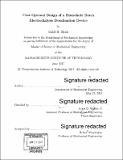| dc.contributor.advisor | Amos G. Winter, V. | en_US |
| dc.contributor.author | Shah, Sahil R. (Sahil Rajesh) | en_US |
| dc.contributor.other | Massachusetts Institute of Technology. Department of Mechanical Engineering. | en_US |
| dc.coverage.spatial | a-ii--- | en_US |
| dc.date.accessioned | 2017-10-18T15:10:42Z | |
| dc.date.available | 2017-10-18T15:10:42Z | |
| dc.date.copyright | 2017 | en_US |
| dc.date.issued | 2017 | en_US |
| dc.identifier.uri | http://hdl.handle.net/1721.1/111935 | |
| dc.description | Thesis: S.M., Massachusetts Institute of Technology, Department of Mechanical Engineering, 2017. | en_US |
| dc.description | Cataloged from PDF version of thesis. | en_US |
| dc.description | Includes bibliographical references (pages 95-100). | en_US |
| dc.description.abstract | This thesis investigates the pareto-optimal design of a household point-of-use batch electrodialysis (ED) system to provide a cost-effective replacement for existing reverse osmosis (RO) devices, for brackish water desalination of Indian groundwater, at lower energy consumption and higher recovery: 80-90% vs 25-40%. Target specifications derived from user-interviews, and RO products, guided the selection of a batch architecture, for which a coupled flow-mass transport model to predict desalination rate was developed, and validated using a lab-scale ED stack. The effects of varying the production rate (9-15 L/hr) and product concentration (100-300 mg/L) requirements on optimal selection of geometry, flow-rates, and applied voltage for total cost minimization were then explored using a multi-objective genetic algorithm. Given the low utilization of the system and the current cost of materials, the energetic cost was dominated by the capital-cost of the system. At a fixed feedwater concentration of 2000 mg/L, which is representative of the upper bound on groundwater salinity underlying much of India, and a recovery ratio of 90%, the capital cost sharply increased for systems targeted at 100 mg/L vs 200 mg/L and 300 mg/L: $141, $93, and $79, respectively averaged for systems that produced between 11.5 and 12.5 L/hr of desalinated water. Promising directions for additional cost reduction include voltage-regulation during the batch process and the development of inexpensive pumps. In addition, a candidate cost-optimal design was prototyped and tested to verify that the measured desalination performance agreed with the modeled expectations. | en_US |
| dc.description.statementofresponsibility | by Sahil R. Shah. | en_US |
| dc.format.extent | 100 pages | en_US |
| dc.language.iso | eng | en_US |
| dc.publisher | Massachusetts Institute of Technology | en_US |
| dc.rights | MIT theses are protected by copyright. They may be viewed, downloaded, or printed from this source but further reproduction or distribution in any format is prohibited without written permission. | en_US |
| dc.rights.uri | http://dspace.mit.edu/handle/1721.1/7582 | en_US |
| dc.subject | Mechanical Engineering. | en_US |
| dc.title | Cost-optimal design of a household batch electrodialysis desalination device | en_US |
| dc.type | Thesis | en_US |
| dc.description.degree | S.M. | en_US |
| dc.contributor.department | Massachusetts Institute of Technology. Department of Mechanical Engineering | |
| dc.identifier.oclc | 1005921919 | en_US |
